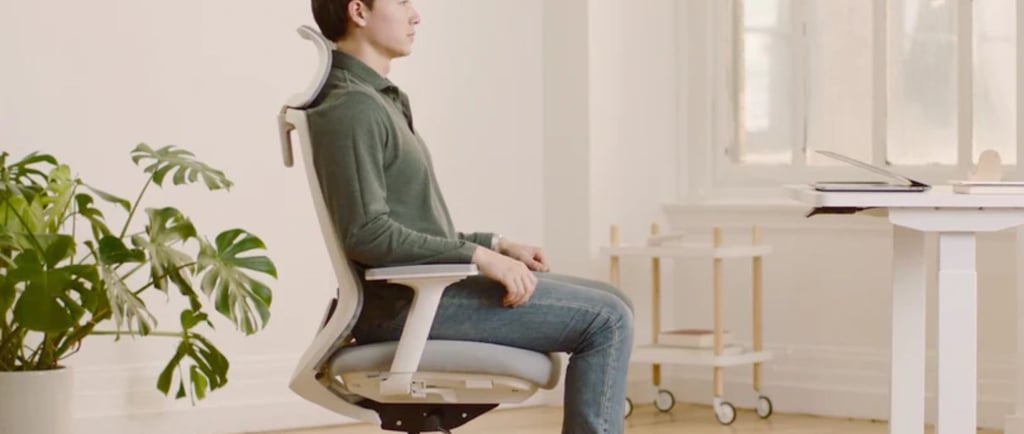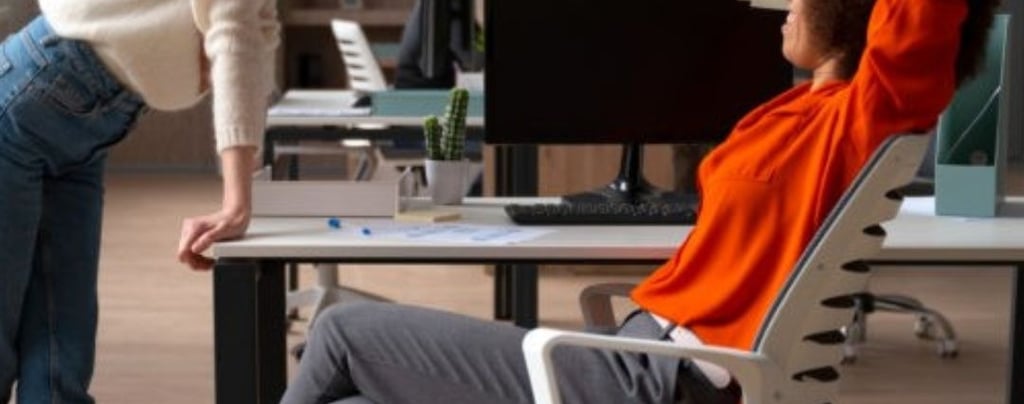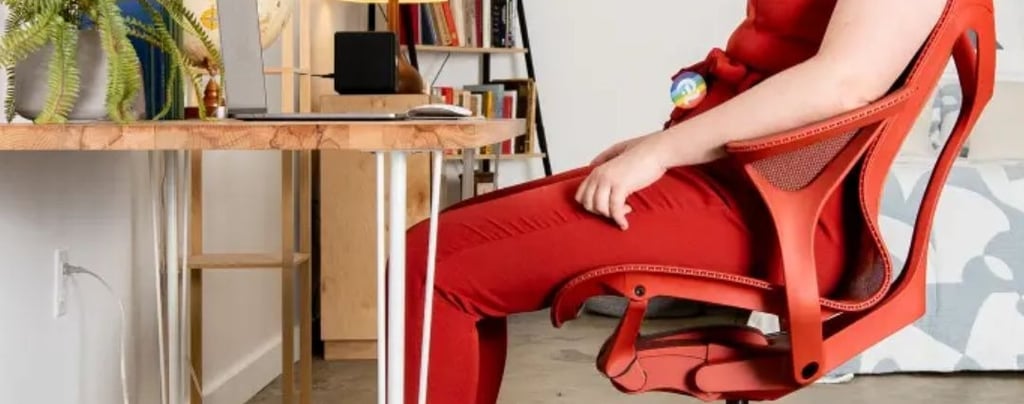The Best Office Chair Designs for Preventing Office Syndrome
Office syndrome, often referred to as "desk jockey" syndrome, is a condition that arises from prolonged sitting in non-ergonomic positions, leading to musculoskeletal problems like neck pain, back pain, and repetitive stress injuries. As more people work from home or in traditional office settings, finding the right office chair has become essential for maintaining health and preventing these issues. The best office chair designs for preventing office syndrome are those that support proper posture, alleviate pressure on the spine, and promote movement throughout the day. Here are some of the top office chair features and designs that can help reduce the risk of office syndrome.
12/27/20244 min read


Office syndrome, often referred to as "desk jockey" syndrome, is a condition that arises from prolonged sitting in non-ergonomic positions, leading to musculoskeletal problems like neck pain, back pain, and repetitive stress injuries. As more people work from home or in traditional office settings, finding the right office chair has become essential for maintaining health and preventing these issues. The best office chair designs for preventing office syndrome are those that support proper posture, alleviate pressure on the spine, and promote movement throughout the day. Here are some of the top office chair features and designs that can help reduce the risk of office syndrome.
1. Ergonomic Chairs with Adjustable Features
An ergonomic office chair is one that is specifically designed to support the body’s natural posture, reduce strain, and provide comfort during long hours of sitting. The key to preventing office syndrome is a chair that offers multiple adjustable features to ensure a perfect fit for each user.
What’s New: Ergonomic chairs with height, armrest, and lumbar adjustments, along with adjustable seat depth and backrest tilt.
Why It’s Innovative: Customizability ensures that the chair accommodates different body types and sitting preferences, encouraging a healthier posture.
2. Lumbar Support Chairs
Lumbar support is crucial in preventing lower back pain, a common symptom of office syndrome. Proper lumbar support helps maintain the natural curve of the spine, preventing slouching and excessive pressure on the lower back.
What’s New: Chairs with dynamic lumbar support that can be adjusted to fit the curvature of your lower back, ensuring optimal spinal alignment.
Why It’s Innovative: Dynamic lumbar support adapts to the user’s movements, offering consistent support throughout the day and reducing pressure on the spine.


3. Mesh Back Chairs for Breathability
Mesh chairs offer an excellent solution for individuals who tend to get hot while sitting for long periods. Mesh fabric provides enhanced breathability, preventing sweat buildup and discomfort, while also offering adequate support.
What’s New: Breathable mesh backrest that promotes airflow and reduces heat buildup during long hours of sitting.
Why It’s Innovative: In addition to comfort, the mesh back provides enough flexibility to maintain posture without feeling too rigid, which is essential for reducing muscle tension.
4. Active Sitting Chairs
Active sitting chairs encourage movement, which is crucial for preventing office syndrome. These chairs are designed to promote natural, dynamic movement while sitting, reducing the negative effects of being sedentary.
What’s New: Ball-based chairs, kneeling chairs, and swivel chairs that engage core muscles and promote balance.
Why It’s Innovative: These designs force users to maintain active posture and avoid slouching, improving circulation and reducing muscle stiffness.
5. Saddle Chairs for Spinal Alignment
Saddle chairs are designed to promote proper spinal alignment by encouraging a natural sitting posture that mimics the position of a rider on a horse. These chairs support the pelvis in a tilted position, which helps maintain the natural curve of the spine.
What’s New: Saddle chairs with adjustable height and tilt for better alignment, offering a more open and natural hip angle.
Why It’s Innovative: Saddle chairs encourage a more active, upright sitting posture, reducing pressure on the spine and promoting better circulation in the lower body.


6. Standing Desk Chairs
To combat the risks of prolonged sitting, some office chairs are designed to work with standing desks. These chairs are built to allow users to sit or lean for short periods, while encouraging standing and moving for the rest of the day.
What’s New: Hybrid standing desk chairs that are height-adjustable, offering seated support during standing desk use.
Why It’s Innovative: These chairs allow flexibility between sitting and standing, reducing the risks of prolonged sitting while providing support during seated intervals.
7. Reclining Office Chairs with Footrests
Reclining chairs with footrests allow users to take pressure off their back and legs by leaning back and supporting their feet. This chair design promotes periodic changes in posture and can encourage relaxation without compromising support.
What’s New: Reclining office chairs with adjustable footrests that help users shift into a more relaxed position, allowing for muscle recovery.
Why It’s Innovative: These chairs promote posture variation by offering the ability to recline and elevate the legs, which can reduce spinal pressure and muscle fatigue.
8. Ergonomic Stool Chairs
Ergonomic stool chairs provide a unique approach to seating. They are designed to be more compact and supportive, while encouraging a more upright posture and engagement of the core muscles.
What’s New: Ergonomic stools that combine minimalism with full back support, allowing for movement and better weight distribution while sitting.
Why It’s Innovative: By promoting an active sitting posture, ergonomic stools engage core muscles and reduce the temptation to slouch, helping prevent lower back pain.
9. Zero Gravity Chairs
Inspired by NASA technology, zero gravity chairs are designed to evenly distribute weight and reduce the pressure exerted on the spine. This chair design elevates the legs and tilts the backrest to relieve pressure points and promote relaxation.
What’s New: Zero gravity office chairs with customizable recline angles that allow users to find the optimal position for spinal alignment.
Why It’s Innovative: By reducing the gravitational pull on the spine, these chairs can alleviate the discomfort caused by prolonged sitting and prevent strain on the back and neck.
10. Customizable Seat Cushions
For those who already own a chair but need additional comfort and support, customizable seat cushions can make a significant difference. These cushions help improve posture by providing extra lumbar or seat support, promoting better spine alignment.
What’s New: Memory foam or gel cushions that mold to the contours of the body, providing enhanced lumbar or seat support.
Why It’s Innovative: Cushions can be easily added to any chair, providing tailored comfort and support that can help prevent the development of office syndrome.
Conclusion
Preventing office syndrome begins with making conscious choices about the office chair we use daily. Whether you're looking for adjustable ergonomic features, lumbar support, or active sitting options, selecting a chair that aligns with your body’s needs is essential for reducing the risk of long-term discomfort. With advancements in chair designs, modern technology, and ergonomic principles, it is easier than ever to ensure that your workspace promotes comfort, proper posture, and overall well-being, helping you to work productively without compromising your health.
Resources
Comprehensive information, practical tips, effective solutions, workplace health
Office Syndrome & Well-being
© 2024. All rights reserved. Designed by Pimclick - SEO Agency
Effective Exercises and Stretches for Relief
The Role of Workplace Wellness Programs
